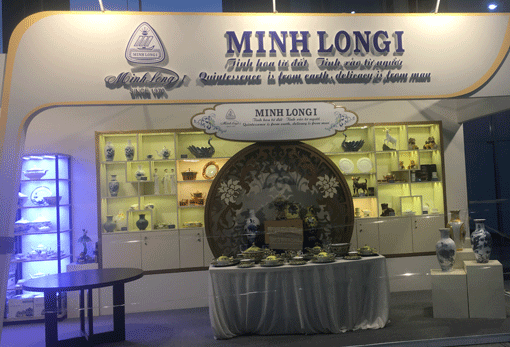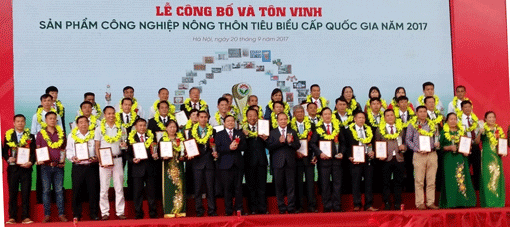1. The need for promulgating the cleaner production program
According to the National Strategy for Environmental Protection to 2020 with a vision to 2030, Strategic orientation for sustainable development in Vietnam and orientation for development of industrial sectors
- The State encourages and provides technical support related to the application of cleaner production on the basis of industrial production facilities' voluntariness and internal strength in order to achieve environmental objectives and economic benefits.
- Cleaner production in the industry is implemented on the basis of strengthening of the state management on environmental protection and awareness of industrial manufacturing establishments about benefits of the cleaner production application.
Binh Duong province contributed 5 out of 102 state-level handicraft products in 2017
Products of Minh Long Co., Ltd were exhibited at the 15th WTA High-Tech Fair in Binh Duong province. The company always pioneers the application of cleaner production solutions and brings about high quality products
2. Legal basis for promulgating the cleaner production program
Pursuant to the Decision No. 1216/QD-TTg dated September 5, 2012 of the Prime Minister approving the National Strategy for Environmental Protection to 2020 with a vision to 2030;
Pursuant to the Decision No. 166/QD-TTg dated January 21, 2014 of the Prime Minister on promulgation of the plan on implementation of the National Strategy for Environmental Protection to 2020 with a vision to 2030;
Pursuant to the Decision No. 76/QD-TTg dated January 11, 2016 of the Prime Minister approving the national action plan on sustainable production and consumption up to 2020 with a vision to 2030.
3. The cleaner production program implementation cost
The cleaner production program implementation cost includes:
3.1 State budget:
- Central budget: in accordance with the 5-year and annual cleaner production strategy implementation cost estimate of the Ministry of Industry and Trade and ministries.
- Local budget: on the basis of the provincial People's Committee's annual cost estimate from environmental protection cost, science and technology cost and industrial promotion cost,...)
3.2. Other lawful capital sources:
- Financial aid of organizations and individuals inside and outside the country.
- Industrial production establishments' funding for the cleaner production application.
4. Expected contents of the cleaner production program
4.1 General objectives:
- To apply cleaner production solutions widely in industrial production facilities in order to improve the efficiency of the use of natural resources, raw materials and fuels and; reduce emissions and pollution; protect and improve the environmental quality, human health and ensure the sustainable development.
- To make the industrial production in Binh Duong province meet general objectives of the Strategy of cleaner production in the industry up to 2020.
- To pay attention to the efficient use of raw materials and energy; reduction of emissions and pollution; protection and improvement of the environment quality, human health and guarantee of sustainable development.
- To raise awareness and capacity of supporting the application of cleaner production; to assist state management agencies in evaluating cleaner production activity implementation results contributing to achieving the general objective of the strategy.
- To support enterprises and industrial production establishments to raise their awareness and capacity and step by step apply cleaner production in production activities.
- To research and apply advanced technologies, efficiently use natural resources, reduce greenhouse gas emissions contributing to effectively deal with climate change.
- To widely and effectively deploy cleaner production activities in Binh Duong province.
4.2 Specific objectives:
The application of cleaner production in industry in Binh Duong province will aim at the following main objectives:
- 90% of industrial production establishments having potential to apply cleaner production will be aware of benefits of the cleaner production application in the industry.
- 50% of industrial production establishments will have potential to apply cleaner production and reduce from 2 to 5% of their consumption of energy, raw materials, per unit of production.
- 100% of staff responsible for cleaner production will be trained and capable of guiding and supporting industrial manufacturing facilities to apply cleaner production.
4.3 Proposed activities:
- To continue to raise awareness and capacity of applying cleaner production in industry.
- To operate the database and electronic information page on cleaner production in industry.
- To provide technical support on cleaner production application to industrial production facilities.
- To build and maintain a network of organizations supporting cleaner production in the industry.
- To develop provincial policies on cleaner production.
5. Solutions:
5.1 Solutions to communication and awareness raising:
a) To promote cleaner production propaganda activities and awareness raising for state management agencies and industrial manufacturing facilities;
b) To develop and disseminate the database and electronic information page on cleaner production in industry;
c) To promote dissemination and scaling up of successful cleaner production application models.
5.2. Solutions on cleaner production policies:
a) To promote the review, amendment, supplement and improvement of policies and legal framework on cleaner production in order to promote the cleaner production application in the industry;
b) To integrate cleaner production contents into strategies plans on development of industrial sectors; strategies and plans on socio-economic development; programs and plans on environmental protection of ministries and localities;
c) To grant certificates on cleaner production application to industrial production establishments voluntarily carrying out cleaner production solutions;
d) To develop a network of cleaner production support organizations in the Ministry of Industry and Trade and provinces and cities under the central government where many industrial production establishments are located.
5.3 Solutions to technical support, human resource training and international cooperation:
a) To promote the development and dissemination of technical guidelines on cleaner production in industry; technical support on cleaner production application for industrial production facilities;
b) To strengthen the cooperation between research institutes, universities and industrial manufacturing establishments in the research, transfer and application of technologies for cleaner production in industry;
c) To promote the training and capacity building for state management officers, specialists and consultants working in the field of cleaner production in industry;
d) To take advantage of resources of foreign organizations and individuals to promote the application of cleaner production in industry.
5.4 Investment and financial solutions:
a / The cleaner production strategy implementation cost should be collected from the state budget, financial aid of domestic and foreign organizations and individuals and other legal capital sources;
b) Ministries and shall develop cleaner production projects and submit them to the competent authorities for approval. The cost of implementation of such projects is from the state bank;
c) The state will provide support to cleaner production projects through the government credit; encourage domestic and foreign organizations and individuals to invest in research, transfer and application of environmentally friendly technologies for cleaner production in industry;
d) Cleaner production application investment projects of industrial production establishments will be entitled to preferential financial policies. The cleaner production strategy executive committee is responsible for advising on financial incentives and submitting them to the Prime Minister for approval.
Binh Duong provincial Center for Industrial Promotion
Traslated: By Office of Cleaner Production and Sustainable Production and Consumption


 Promoting the cold storage market to optimize the strengths of agricultural products
Promoting the cold storage market to optimize the strengths of agricultural products
.jpg?w=280&h=160&mode=crop) Greening the textile industry from the perspective of ESCO model
Greening the textile industry from the perspective of ESCO model
 VICEM strives towards sustainable development
VICEM strives towards sustainable development
 Develop new tool to reduce, reuse and recycle in industry
Develop new tool to reduce, reuse and recycle in industry
 Bac Kan promotes sustainable production and consumption
Bac Kan promotes sustainable production and consumption
 Germany's new plant produces zero-emission jet fuel
Germany's new plant produces zero-emission jet fuel
 Encouraging results from watershed pollution control
Encouraging results from watershed pollution control
.jpg?w=280&h=160&mode=crop) Promote energy labeling towards high efficiency products
Promote energy labeling towards high efficiency products